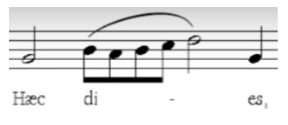“Haec Dies” by William Byrd
This week, we will be taking it back now, y’all – a couple centuries back. William Byrd (1540-1623) was one of the most significant composers of the Renaissance era, and almost certainly the most significant composer of English Music of this time. Byrd’s life was shaped by music from a very early age. Born in London, he was a chorister at the Chapel Royal (basically the Royal Family’s liturgical choir) as a child, where he studied music under Thomas Tallis, the other musical giant of English Renaissance music. Byrd sang as a boy soprano under Tallis’ baton until his voice changed, at which point he began serving as Tallis’ assistant. Later in life, he returned to the Chapel Royal to sing in the tenor/bass section of the choir and serve as organist. This strong royal connection served Byrd well, as he and Tallis were later granted unprecedented publication and printing rights for their music by Queen Elizabeth I.
Byrd, a staunch Catholic, lived through a time of religious and political flux – Henry VIII was a Catholic (until his disagreement with the pope regarding divorce), Edward VI was Protestant; Mary Tudor, a Catholic; Elizabeth I tried to stay in the middle, and James I was a Protestant. In Byrd’s music, we can often get a sense of what era his music was written, or at the very least what type of occasion it was for by the language of the work. Pieces in English were for Protestant events, and Latin pieces were for Catholic events. Under Protestant reign in Renaissance England, Catholics were often greatly persecuted, and Byrd’s Latin compositions were written to be sung in secret at the houses of Catholic aristocrats.
“Haec Dies” by Byrd is a short little Easter anthem that may have been performed at one of those private house services. The piece seemed appropriate because of the familiarity of that idea – a holy Easter service, performed at home. Of course, at FPC, we are not worshipping at home to avoid persecution, but there is such a beautiful connection in communal worship finding a way now just as it did in Renaissance England.
I intentionally chose a video where we can see the music, so that we can see how Byrd passes musical ideas from part to part. At the beginning of the piece, notice how each “Haec dies” has the same musical figure (I use that term intentionally, because even if you cannot read music, you can see how that general shape of open notehead, notes connected by lines, etc. appears in different parts). The reuse of this motive (a recognizable musical figure) creates a beautiful image of the people of God all shouting out their praises in different places and times. Fitting, isn’t it?

I also found this piece to be a good analogy for the weird state of quarantine. “Haec Dies,” if analyzed, is immensely complex and busy; yet if you take a step back and detach from the intricacies, the music just washes over you, and is somehow meditative. While we are all staying in the same place, some of our lives have become busier – juggling work, children, teaching, etc. For those people, I’d encourage you to embrace the wider scope, and let the music wash over you. For others, quarantine is just boring. For you, maybe try to take the time to analyze this piece and dig into its inherent intricacies. See if you can find more sharing of musical ideas in the “Alleluia” section at the end!
Of course, these two mindsets apply to more than just this piece. God has provided enough complexity and enough peace for you wherever you may be. It’s just in how we look at it.
2 Corinthians 9:8 “And God is able to bless you abundantly, so that in all things at all times, having all that you need, you will abound in every good work.”
And as the familiar text of “Haec Dies” says:
This is the day that the Lord has made:
Let us rejoice and be glad in it.
Alleluia.

